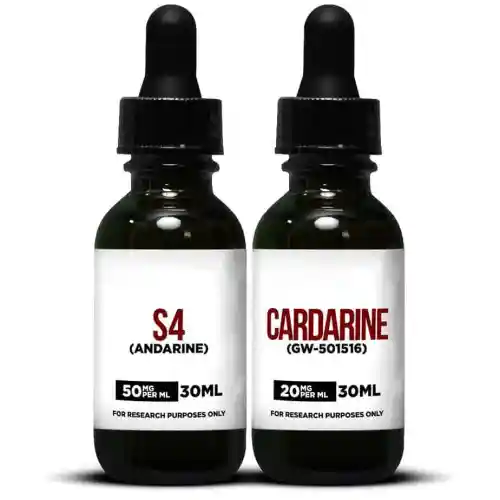Protocol for Researching the Shred Bundle:
S4 – For research purposes only, 1 filled oral syringe daily. S4 Andarine can be researched for up to 8 weeks. After a cycle of S4 Andarine is completed, a 30-day break should be taken before resuming research.
Cardarine – For research use only, 1 filled oral syringe daily. Research can be done for up to 12 weeks. A 6-week break is needed after 12 weeks of research, before beginning research again.
S4
Andarine (developmental code names GTx-007, S-4) is an investigational selective androgen receptor modulator (SARM) developed by GTX, Inc for treatment of conditions such as muscle wasting, osteoporosis and benign prostatic hypertrophy (BPH), using the nonsteroidal antiandrogen bicalutamide as a lead compound.
Andarine is an orally active partial agonist of the androgen receptor (AR). In intact male rats, 0.5 mg andarine daily was shown to reduce prostate weight to 79.4%, and non-significantly increased levator ani muscle weight. In castrated male rats, this dose restored only 32.5% prostate weight, but 101% levator ani muscle weight. This suggests that andarine is able to competitively block binding of dihydrotestosterone to its receptor targets in the prostate gland, but its partial agonist actions at the androgen receptor prevent the side effects associated with the antiandrogens traditionally used for treatment of BPH.
Cardarine
GW501516 was initially discovered during a research collaboration between GSK and Ligand Pharmaceuticals that began in 1992. The discovery of the compound was published in a 2001 issue of PNAS. Oliver et al. reported that they used “combinatorial chemistry and structure-based drug design” to develop it. One of the authors was the son of Leo Sternbach who discovered benzodiazepines in the 1960s.
R & D Focus Drug News reported that GSK began phase I trials of the compound for the treatment of hyperlipidemia in 2000 followed by phase I/II in 2002. In 2003, Ligand Pharmaceuticals earned a $1 million payment as a result of GSK continuing phase I development.
By 2007, GW501516 had completed two phase II clinical studies and other studies relating to obesity, diabetes, dyslipidemia and cardiovascular disease, but GSK abandoned further development of the drug in 2007 for reasons which were not disclosed at the time. It later emerged that the drug was discontinued because animal testing showed that the drug caused cancer to develop rapidly in several organs, at dosages of 3 mg/kg/day in both mice and rats.
Ronald M. Evans’s laboratory purchased a sample of GW501516 and gave mice a much higher dose than had been used in GSK’s experiments; they found that the compound dramatically increased the physical performance of the mice. The work was published in 2007 in Cell and was widely reported in the popular press including The New York Times and The Wall Street Journal.

